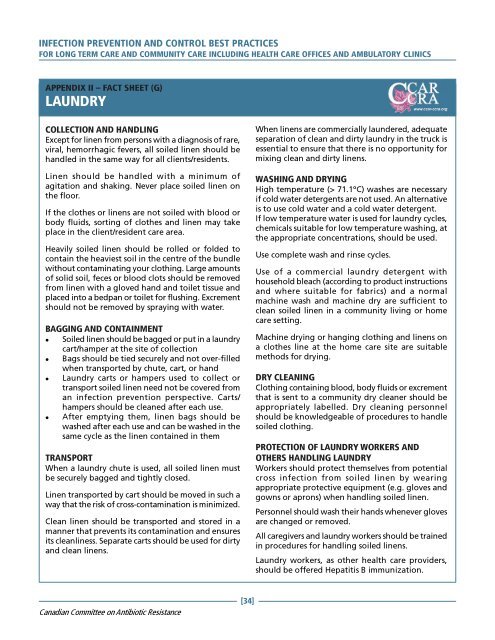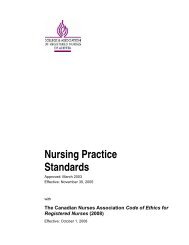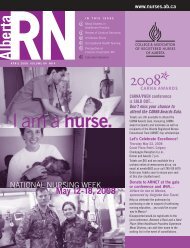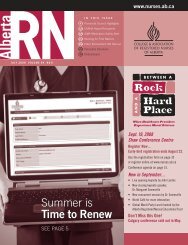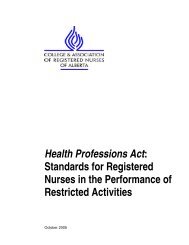Infection Prevention and Control Best Practices - College ...
Infection Prevention and Control Best Practices - College ...
Infection Prevention and Control Best Practices - College ...
Create successful ePaper yourself
Turn your PDF publications into a flip-book with our unique Google optimized e-Paper software.
INFECTION PREVENTION AND CONTROL BEST PRACTICES<br />
FOR LONG TERM CARE AND COMMUNITY CARE INCLUDING HEALTH CARE OFFICES AND AMBULATORY CLINICS<br />
APPENDIX II – FACT SHEET (G)<br />
LAUNDRY<br />
COLLECTION AND HANDLING<br />
Except for linen from persons with a diagnosis of rare,<br />
viral, hemorrhagic fevers, all soiled linen should be<br />
h<strong>and</strong>led in the same way for all clients/residents.<br />
Linen should be h<strong>and</strong>led with a minimum of<br />
agitation <strong>and</strong> shaking. Never place soiled linen on<br />
the floor.<br />
If the clothes or linens are not soiled with blood or<br />
body fluids, sorting of clothes <strong>and</strong> linen may take<br />
place in the client/resident care area.<br />
Heavily soiled linen should be rolled or folded to<br />
contain the heaviest soil in the centre of the bundle<br />
without contaminating your clothing. Large amounts<br />
of solid soil, feces or blood clots should be removed<br />
from linen with a gloved h<strong>and</strong> <strong>and</strong> toilet tissue <strong>and</strong><br />
placed into a bedpan or toilet for flushing. Excrement<br />
should not be removed by spraying with water.<br />
BAGGING AND CONTAINMENT<br />
� Soiled linen should be bagged or put in a laundry<br />
cart/hamper at the site of collection<br />
� Bags should be tied securely <strong>and</strong> not over-filled<br />
when transported by chute, cart, or h<strong>and</strong><br />
� Laundry carts or hampers used to collect or<br />
transport soiled linen need not be covered from<br />
an infection prevention perspective. Carts/<br />
hampers should be cleaned after each use.<br />
� After emptying them, linen bags should be<br />
washed after each use <strong>and</strong> can be washed in the<br />
same cycle as the linen contained in them<br />
TRANSPORT<br />
When a laundry chute is used, all soiled linen must<br />
be securely bagged <strong>and</strong> tightly closed.<br />
Linen transported by cart should be moved in such a<br />
way that the risk of cross-contamination is minimized.<br />
Clean linen should be transported <strong>and</strong> stored in a<br />
manner that prevents its contamination <strong>and</strong> ensures<br />
its cleanliness. Separate carts should be used for dirty<br />
<strong>and</strong> clean linens.<br />
Canadian Committee on Antibiotic Resistance<br />
[34]<br />
When linens are commercially laundered, adequate<br />
separation of clean <strong>and</strong> dirty laundry in the truck is<br />
essential to ensure that there is no opportunity for<br />
mixing clean <strong>and</strong> dirty linens.<br />
WASHING AND DRYING<br />
High temperature (> 71.1ºC) washes are necessary<br />
if cold water detergents are not used. An alternative<br />
is to use cold water <strong>and</strong> a cold water detergent.<br />
If low temperature water is used for laundry cycles,<br />
chemicals suitable for low temperature washing, at<br />
the appropriate concentrations, should be used.<br />
Use complete wash <strong>and</strong> rinse cycles.<br />
Use of a commercial laundry detergent with<br />
household bleach (according to product instructions<br />
<strong>and</strong> where suitable for fabrics) <strong>and</strong> a normal<br />
machine wash <strong>and</strong> machine dry are sufficient to<br />
clean soiled linen in a community living or home<br />
care setting.<br />
Machine drying or hanging clothing <strong>and</strong> linens on<br />
a clothes line at the home care site are suitable<br />
methods for drying.<br />
DRY CLEANING<br />
Clothing containing blood, body fluids or excrement<br />
that is sent to a community dry cleaner should be<br />
appropriately labelled. Dry cleaning personnel<br />
should be knowledgeable of procedures to h<strong>and</strong>le<br />
soiled clothing.<br />
PROTECTION OF LAUNDRY WORKERS AND<br />
OTHERS HANDLING LAUNDRY<br />
Workers should protect themselves from potential<br />
cross infection from soiled linen by wearing<br />
appropriate protective equipment (e.g. gloves <strong>and</strong><br />
gowns or aprons) when h<strong>and</strong>ling soiled linen.<br />
Personnel should wash their h<strong>and</strong>s whenever gloves<br />
are changed or removed.<br />
All caregivers <strong>and</strong> laundry workers should be trained<br />
in procedures for h<strong>and</strong>ling soiled linens.<br />
Laundry workers, as other health care providers,<br />
should be offered Hepatitis B immunization.


